Respect for Nature and harmony with the seasons

Shaped by volcanic eruptions and forces of nature, nearly 70 percent of Japan is made up of majestic mountains and stunning peaks. Nature has been featured in countless stories and artwork as powerful symbols of enchantment and mystery since ancient times, and the influence of Nature on daily life and culture has been enormous particularly in Japan, where its people have viewed Nature's forces with reverence and awe for thousands of years.

Tall cedar trees lining the walkway to Tokagushi’s inner shrines. (Image credit: JR East / Carissa Loh)
Living on an island subject to constant volcanic and seismic activity, Japan’s ancient dwellers practiced mountain worship (山岳信仰 sangaku shinkō), a faith worshipping mountains as being sacred. Mountain worship eventually evolved into the religion of Shintō (神道), which means "The way of the Gods", where it is believed that all things, especially natural elements like mountains, rivers, and forests, have a deity (神 kami) residing within.
On one hand, Nature was feared as it frequently brought about devastating disasters like earthquakes, typhoons and bitterly cold winters; but on the other hand it was venerated for being the source of everything essential for life: water, food and shelter. Due to these Shintō beliefs, Japanese people hold a great respect and deep admiration for Nature.
A temple at Yamadera (Image credit: 山形県庁)
In particular, mountains were considered especially sacred, with numerous mountains having dedicated shrines or temples on their peaks. For hundreds of years, believers have been embarking on religious pilgrimages in droves as a way of expressing their thanks or for seeking salvation. Soaring mountains were seen as a world away, shrouded in clouds and rising up into the heavens. They were also revered for being the source of life-giving streams and rivers that provided water for survival.
Nowadays however, mountain-climbing culture has really seen a boom, with many Japanese people enjoy hiking and leisurely climbs as a way to appreciate and enjoy nature.

Rice fields in Niigata, a prefecture most famous for quality rice and rice products. (Image credit: 公益社団法人 新潟県観光協会)
The significance of Nature in Japan is unrivalled, with people turning to Nature for guidance through the seasons, and nature’s importance forming the basis for a majority of the festivals (祭り matsuri) which take place throughout the year. All year round, Japan is blessed with rich products of nature – from crops and fish for consumption, to wood and rocks for building materials. It should come as no surprise that the mind set to worship and respect Nature has been around for a long time, with festivals being held to wish for bountiful harvests and good catches.

Geibikei Gorge in the four different seasons. Clockwise from top left: winter, spring, autumn, summer. (Image credit: Geibi Kanko Center)
Shun (旬), the concept of enjoying food and experiences at the peak of their seasons, plays a huge part in everyday life in Japan. Due to its geographic location, Japan experiences four distinct seasons. Many other countries also have four seasons, but in Japan they are distinguished in such a unique way that is hardly seen in other parts of the world, with many seasonal customs and traditions specific to that time of the year.
Spring: appreciating the fleeting beauty of Japan’s beloved cherry blossoms
One such example is hanami (花見 flower-viewing) during the cherry blossom (桜 sakura) season. Cherry blossom trees can be found all around the world, but Japan is especially known for them, with cherry blossoms being one of Japan's most iconic symbols.
Cherry blossoms in full bloom. (Image credit: JR East / Carissa Loh)
The lifespan of cherry blossoms is often used in works of literature as metaphors: blooming in a fleeting moment of beauty, followed by a quick death as they fall off a few days after. The association of Japan with the cherry blossom is this symbolism of and appreciation for its transient beauty, rather than just the presence of the cherry blossoms.
Eastern Japan has plenty of wonderful cherry blossom viewing spots which can be enjoyed over an extended period from early April to early May, due to the region spanning a long distance from north to south.
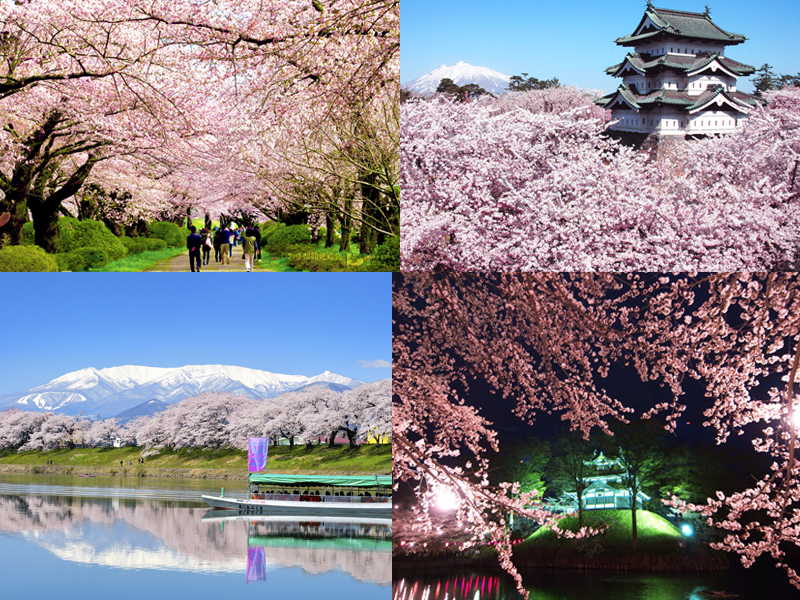
Clockwise from top left: Kitakami Tenshochi Park, Hirosaki Castle Park, Takada Castle Park, Hitome Senbonzakura. Image credits: 岩手県観光協会, Hirosaki City/JNTO, 公益社団法人 新潟県観光協会, U-media)
Kitakami Tenshochi Park (北上展勝地公園 Kitakami tenshochi kōen) in Iwate Prefecture is known for its two-kilometre cherry blossom tunnel and horse wagon rides.
Takada Castle Park (高田城公園 Takadajō kōen) in Niigata Prefecture boasts a fantastic night time illumination, and is one of the top three places in Japan for enjoying cherry blossoms at night.
At Hitome Senbonzakura (一目千本桜) in Miyagi Prefecture, thousands of cherry blossoms line the banks of the Shiroishi River, and its view with Mount Zao in the background is second to none.

Top: Hirosaki Castle Park’s Western Moat during the day and at night. Bottom: View of Hirosaki Castle with the cherry blossoms and Mount Iwaki, and the cherry blossom carpet. (Image credits: JR East / Carissa Loh (top), Hirosaki City / JNTO (bottom).
Up north at Hirosaki Castle Park (弘前公園 Hirosaki kōen) in Aomori Prefecture, techniques taken from apple cultivation have been adapted to grow denser and more beautiful cherry blossom trees. The park offers varying views during the day time and at night, so come at both times if you can. A famous sight is that of the cherry blossom carpet (花筏 hana ikada), which happens when the petals fall off and accumulate on the still waters of the moat, forming a pink carpet.
Yukigata: the age-old method signalling the coming of spring
While waiting for spring to come around, Japanese farmers of the past turned to nature to give them signs for when it was ready to plant crops. Merely going with a certain day of a certain month was not accurate due to different conditions each year, and nature could provide better indicators of farming suitability.
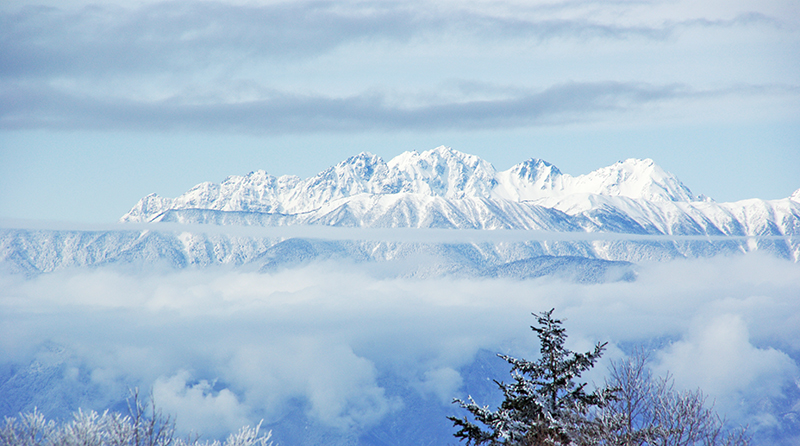
Snow covering the Hotaka mountain range. (Image credit: Yasufumi Nishi / JNTO)
One of these signs was yukigata (雪形 snow shapes). In the olden times, the melting of snow and revealing of the underlying dark rocks were a sign of spring, which the locals used as signs to start preparing their fields for the planting of rice. When snow melts, the mixture of white snow and dark rock form certain recognisable shapes. The features of the mountains would not change unless a disaster comes, so the locals knew that the melting shapes formed would be consistent every year, indicating that spring is upon them.

Hakuba’s horse-shaped yukigata. (Image credit: Tourism Commission of Hakuba Village)
In fact, the famous ski resort of Hakuba (白馬) got its name from the various horse-like snow patterns that form in the beginning of spring: Hakuba means "white horse"! There are many more yukigata patterns are scattered on the mountains around Hakuba, and the Hakuba Highland Hotel has good images of them.

Butterfly-shaped yukigata on Mount Chōgatake (left) and yukigata of a praying monk on Mount Jōnen (right). (Image credit: 安曇野市観光交流促進課)
Similarly, Mount Chōgatake (蝶ヶ岳 Chōgatake) in the Northern Alps also got its name from the butterfly-shaped yukigata that forms on its peak (蝶 means "butterfly" and 岳 means "peak"), while Mount Jōnen (常念岳 Jōnendake) got its name from the yukigata of the praying monk Jōnenbō (常念坊) that forms on its mountain face. If you are interested in hiking up the Northern Alps around Mount Jōnen and Mount Chōgatake, check out this article!
Shinryoku: the season of verdant greenery
For the Japanese, after spring and before summer there is a period known as shinryoku (新緑 fresh greens), when new leaves sprout after the flowers have bloomed.

Fresh greenery along the Oirase Keiryu Stream. (Image credit: JR East / Carissa Loh)
You might think, “What's so special? Trees in Singapore are green all year round.” However, when these new leaves first start to sprout, they are a bright and beautiful green – fresh and vibrant, very different from the darker, duller green of our streets. Shinryoku is a sign that the weather has warmed up and outdoor activities can be enjoyed.
One place where you can enjoy the fresh greens is Bijinbayashi (美人林) in Niigata prefecture.
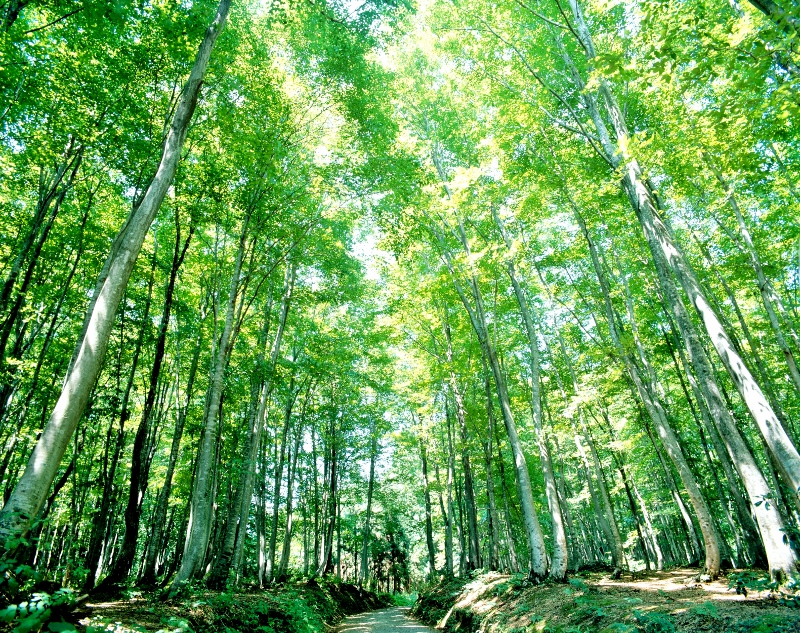
Immerse yourself in rows of beech trees at Bijinbayashi. (Image credit: 公益社団法人 新潟県観光協会)
No matter the season, this forest already looks like it came from a painting with its beautiful beech trees. Though still relatively unknown to foreigners, Bijinbayashi, which means "beauty forest", is quickly becoming well-known as a power spot for local Japanese. Power spots are places people visit to recharge their spirits by feeling the healing energy of the earth and enjoying the mystical scenic beauty.
Shinrinyoku: bathing in the energy of nature
The visiting of power spots located in forests can be considered a type of shinrinyoku. Shinrinyoku (森林浴 shinrin’yoku) literally means "forest bathing", and refers to making a recreational trip to the forests for relaxation and rejuvenation, with the intention of improving your mental or physical well-being.
There are no actual baths involved in shinrinyoku. Instead, it consists of soaking and immersing yourself in the forest atmosphere, and is not just about spending time in nature or going hiking. While people go on hikes and climbs to reach a destination, shinrinyoku focuses more on the journey.

Beech forest on the Shinetsu Trail (Image credit: Shinshu Iiyama Tourism Bureau)
Shinrinyoku is a sensory experience and state of mind where you utilise your different senses to take in energy from nature. Other than the seeing with your eyes, experiences like the sound of flowing water or the rustling of leaves, the scent of flowers or trees, and the feel of the wind in your face contribute to a relaxing journey.
Summer: the season for festivals and hiking
After planting seeds in spring, summer is the season for growth, before harvesting comes in autumn. People of the past used this time to give thanks and to pray for good harvests in autumn, leading to the rise of summer festivals.

Clockwise from top left: Aomori Nebuta Festival, Sendai Tanabata Festival, Morioka Sansa Odori, Akita Kanto Festival, Yamagata Hanagasa Festival. (Image credit: JR East / Carissa Loh)
Tohoku has some of the most vibrant summer festivals in all of Japan, with the big three being the Akita Kanto Festival (秋田竿燈祭り Akita kantō matsuri), the Aomori Nebuta Festival (青森ねぶた祭り Aomori nebuta matsuri) and the Sendai Tanabata Festival (仙台七夕祭り Sendai tanabata matsuri).

Akita Kanto Festival. (Image credit: 秋田県観光連盟)
The Akita Kanto Festival prays for a bountiful harvest, where the kantо̄ (竿燈 lanterns on bamboo poles) resemble ears of rice plants waving in the air and scaring away bad spirits.

Aomori Nebuta Festival. (Image credit: 青森県)
Aomori prefecture's Nebuta and Neputa festivals originated from using lanterns to scare away demons that plagued the farmers, while the Sendai’s Tanabata Festival sees locals making wishes and expressing gratitude.

Happo Pond, a 90-minute hike from the top of the Happo Gondola Station. (Image credit: Tourism Commission of Hakuba Village / JNTO)
Other than festivals, summer means that the snow on the mountains has melted, making it a good time to explore. Hiking and mountain-climbing culture in Japan has really boomed into a recreational activity in modern times. In the past, trips to mountains were made by devotees to reach out to the gods, but nowadays, trips to mountains are mostly for leisure—to enjoy the scenery and serenity.

Kamikochi’s iconic Kappa Bridge. (Image credit: Matsumoto City / JNTO)
Kamikochi (上高地 Kamikōchi) in the mountainous Nagano prefecture is a pristine highland region with a stunning view of the Japanese Alps in the background, offering various hiking trails for all levels. Its name literally means “the grounds where gods descended”, and comes from the arrival of the Shintō god Hotaka-no-mikoto (穂高見命), who was believed to have descended on Mount Oku-hotakadake (奥穂高岳), which can be reached after a 9-hour climb from Kamikochi.

Mountain huts offer a place to sleep for longer hikes, and also sell food and snacks for day visitors. (Image credit: JR East / Carissa Loh)
Mountain huts (山小屋 yamagoya) are present on most peaks, where visitors can spend a night before continuing on their hike. If you are not a fan of climbing, there are also many short and flat hikes available all over the Eastern Japan region.
Autumn: the season of abundant harvests and vibrant colours
Like how hanami (花見) is used to refer to flower-viewing activities especially during the cherry blossom season, there is also an autumn equivalent, momijigari (紅葉狩り), which is the viewing of autumn scenery. With plenty of nature sites around the island, Japan has gorgeous autumn foliage spots all over the country, especially in Eastern Japan.

The hike up to Karasawa Kaar in autumn. (Image credit: JR East / Carissa Loh)
Home to numerous mountain ranges and multiple national parks, Eastern Japan has some of Japan’s most stunning autumn foliage spots. It has a vast area of land and a small population compared to major metropolitan areas, and autumn is perfect for weekend getaways to appreciate the colours, with hiking being a popular activity.

Autumn at Naruko Gorge. The iconic bridge (left) and Resort Minori train passing through the tunnel in the gorge (right). (Image credit: 宮城県観光課 (left) and JR East (right))
Some of the best places to catch autumn colours include Naruko Gorge (鳴子峡 Narukokyō) in Miyagi Prefecture, and Oirase Keiryu (奥入瀬渓流 Oirase keiryū) in Aomori Prefecture.

Mount Hachimantai in autumn. (Image credit: JR East)
While some scenery is only accessible by hiking into the mountains, there are also some stunning mountain views that are only a ropeway ride away. These are great for those who do not have the energy or time to climb, or for those travelling with elderly and young children. Mount Hachimantai in Akita/Iwate Prefecture and Mount Hakkoda in Aomori Prefecture are some examples of such places. As you ride up the ropeway, take in a stunning panoramic view of the deep red and orange trees in autumn.

Chestnuts, Matsutake mushrooms, apples and Shine Muscat grapes. (Image credit: Pixabay and JR East / Carissa Loh)
Autumn is the season for harvest. The Japanese celebrate not just by viewing the colourful foliage, but also by savouring delicious dishes made with ingredients that are freshly harvested in autumn. Typical autumn delicacies include chestnuts (栗 kuri), Matsutake mushrooms (松茸 matsutake), apples (りんご ringo) and grapes (葡萄 budō), all of which are abundant in the mountainous prefecture of Nagano.
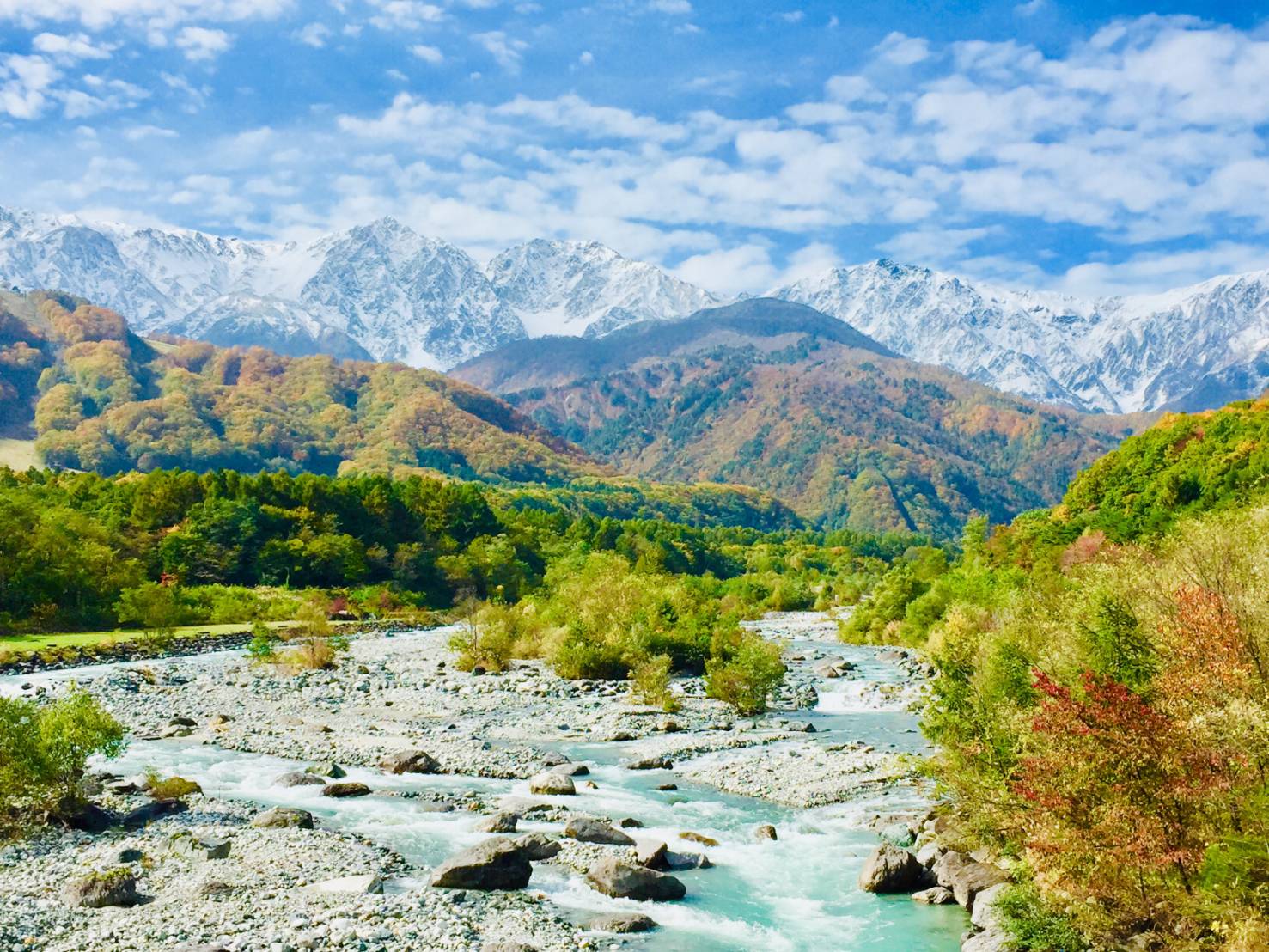
Sandankōyō at Hakuba. (Image credit: JR East / Akio Kobori)
Eastern Japan has some of Japan’s highest peaks, so you can even see snow together with autumn foliage! It usually starts snowing much earlier at the top of high mountains, but the nearby lower mountains are still developing autumn colours, while the ground level is still green. This phenomenon is known as sandankōyō (三段紅葉 three layers of autumn colours), and is exceptionally beautiful at Hakuba.
Winter blessings
When autumn leaves fall off and temperatures drop, it is a signal that winter is coming. Eastern Japan is home to prefectures with mountainous terrain, prefectures on high altitudes and prefectures along the Sea of Japan. All of these conditions contribute to cold, harsh winters and high snowfall, with the areas receiving some of the highest snowfall in Japan and in the world.

Ski resorts in Hakuba, GALA Yuzawa and Appi Kogen. (Image credits: Tourism Commission of Hakuba Village / JNTO (left), GALA Yuzawa Snow Resort (centre), Hotel Appi Grand (right))
With high snowfall, it is no surprise that Niigata and Nagano are the top two prefectures in Japan for having the most number of ski resorts, including the world-renowned Hakuba Valley, Japan’s largest ski resort, which offers top-quality powder snow, and amazing views from its high slopes.
Due to the strong presence of natural forces in the Eastern Japan region, many of its unique sightseeing spots in winter are actually shaped by Nature!

Snow monsters at Yamagata Zao. (Image credit: 山形県庁)
The most well-known phenomenon is probably snow monsters (樹氷 juhyō). Snow monsters are a natural phenomenon that occur due to frost and snow accumulating on trees. Over time, it accumulates until the shape resembles that of a monster, hence the name "snow monsters". Some even have night illuminations, giving an eerie yet magical feel. There are many places to see them, with the most famous being Yamagata Zao. Others include Mount Moriyoshi in Akita, and Mount Hakkoda in Aomori. The best season for viewing the shapes are early to mid-February.

Omiwatari on Lake Suwa. (Image credit: Suwa Tourism Association)
Lake Suwa (諏訪湖 Suwako) is the largest lake in Nagano, and sometimes freezes during winter. On rare occasions (getting rarer due to global warming), you can witness a very special phenomenon known as omiwatari (御神渡り), which means "God's crossing". Omiwatari occurs when the ice on the lake expands and contracts due to temperature fluctuations between day and night. The ice cracks in an elevated line of ridges on the surface of the lake, which is known as omiwatari. Even if you cannot witness the omiwatari, you can still try walking on the frozen surface of the lake or go wakasagi smelt-fishing if the conditions are right.
Winter means plenty of snow and long, dark nights, so naturally many of the season’s festivals revolve around light and snow.

Tokamachi Snow Festival. (Image credit: 十日町雪まつり実行委員会)
The town of Tokamachi (十日町 Tōkamachi) in Niigata Prefecture has one of the highest snowfalls in Japan, and sometimes the snow might cause inconvenience for daily life. Instead of thinking of it negatively, the snowfall is celebrated with the Tokamachi Snow Festival (十日町雪まつり Tōkamachi yuki matsuri), where many beautiful sculptures made from snow and ice are created.

Yokote city’s Kamakura Festival. (Image credit: Tohoku Tourism Promotion Organization)
The Yokote Kamakura Festival (横手の雪まつり Yokote no yuki-matsuri) is a festival dedicated to the water deity, and is held annually on 15–16 February in the city of Yokote (横手) in Akita Prefecture. Featuring an array of fun activities, the festival shines a spotlight on kamakura (かまくら), which are snow huts/igloos. Inside each kamakura is an altar made of snow, where people can pray to the water deity.

Mini kamakura. (Image credit: Tohoku Tourism Promotion Organization)
Visitors can even experience building their own kamakura snow huts! In addition, the Yokote Kamakura Festival features mini kamakura which are illuminated with candles at night, creating a magical atmosphere, especially if it snows!
Public holidays dedicated to nature: Mountain Day, Greenery Day and Marine Day
One of Japan’s newest public holidays, Mountain Day (山の日 Yama-no-hi), falls on 11 August and was started in 2016, dedicated to appreciating mountains and nature. Other existing public holidays dedicated to nature include Greenery Day (緑の日 Midori-no-hi) on 4 May, and Marine Day (海の日 Umi-no-hi) on the 3rd Monday of July. The fact that three days dedicated to nature made it as public holidays in Japan is testament to the importance of nature in the lives of its people.
(Note: Due to the 2020 Tokyo Olympics, Marine Day has been scheduled for 23 July 2020, while Mountain Day will be observed on 10 August 2020 instead. )
Visit Japan in all four seasons
With distinct seasons and shun (旬), Japan is a country that you can visit multiple times and always discover something new. A single place can offer diverse experiences, depending on the time of year you visit!

Oirase Keiryu in summer, autumn and winter. (Image credit: JR East / Carissa Loh)
As someone who has visited all of Japan’s 47 prefectures, I still want to keep going back, to see the same places in different seasons. Colourful flowers in spring, lush greenery in summer, warm foliage in autumn and powdery white snow in winter—each season brings a new element to the experience! Other than just scenery to look at, there are also different scents in the each seasons, different seasonal delicacies to savour, different textures to feel and different sounds to listen to.

Eastern Japan offers different views and experiences throughout the four seasons. (Image credit: JR East / Carissa Loh)
The Eastern Japan region is exceptionally rich and diverse in nature, tradition and culture. There are so many things to do all year round, and I highly recommend visiting in different seasons for an unforgettable and fulfilling experience. Don’t forget to taste the season’s best ingredients and dishes for an even more memorable trip!
Getting around

The new JR EAST PASS (Tohoku area). (Image credit: JR East)
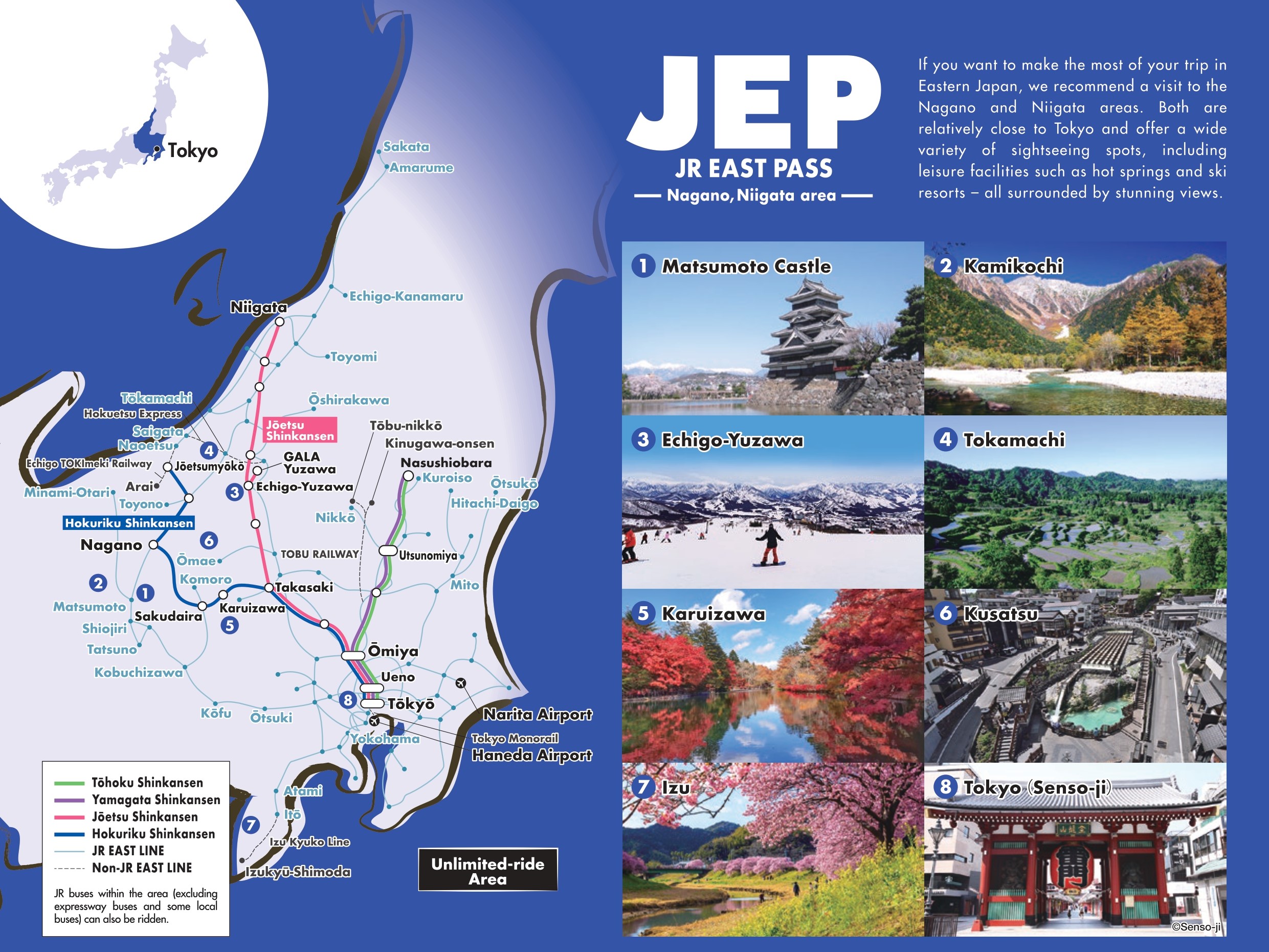
The new JR EAST PASS (Nagano, Niigata area). (Image credit: JR East)
No matter the season, JR East Passes offer substantial discounts, and unlike other passes, can also be used by foreign passport holders living in Japan. There are two types, with both offering unlimited rides on JR East lines (including bullet trains) in their designated areas for 5 consecutive days. Pass holders can also make seat reservations for bullet trains, some limited express trains and Joyful Trains online for free, up to 1 month in advance, on the JR-EAST Train Reservation.

The JR-EAST Train Reservation. (Image credit: JR East)
The JR EAST PASS (Tohoku area) is only ¥30,000, while the JR EAST PASS (Nagano, Niigata area) is only ¥27,000. Both passes can be used for automatic ticket gates, and foreign passport holders living in Japan are also eligible to use these passes.
Header image credit: JR East / Akio Kobori




